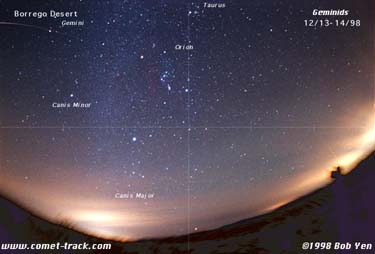

frame #9 (11:45pm - 11:00pm PST, 12/13)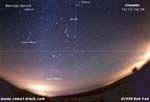 Click for HI-RES image |
NOTE: This is the SAME fireball, as recorded with the 8mm (see 8mm section) Note the LONG (apparent) 90+ deg meteor-trail (!). (just considering the bright portion). Actually, you can trace the trail ALL the way to the western horizon, which implies nearly a 180 deg trail (!!). Look carefully, you can see the *faint* trail. The end-trail (not visible, see 8mm section) has increasing breadth, with a bulge-like terminus. Note the faint red-nebulosity characteristic to Orion: Barnard's Loop & ?? circular-nebula (near Betelgeuse) |
frame #19 (1:45am - 2:00am PST, 12/14)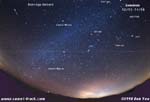 Click for HI-RES image |
NOTE: This is the SAME fireball, as recorded with the 8mm camera-cluster (see 8mm section) 20+ deg meteor-trail, through Hydra (below Leo). The radiant is from Gemini (near Castor), which is near the zenith. Note Orion, with it's characteristic faint red-nebulosity: Barnard's Loop & ?? circular-nebula (near Betelgeuse). Also, the familiar "triangle" formed by Taurus, M45 (aka Pleiades cluster), NGC1499 (California Nebula, large reddish blob) |
frame #33 (4:00am - 4:05am PST, 12/14)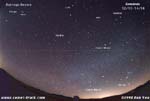 Click for HI-RES image |
NOTE: This is the SAME fireball, as recorded with the 8mm camera-cluster (see 8mm section), 14mm camera-cluster (see 14mm section), 24mm camera-cluster (see 24mm section), 35mm camera-cluster (see 35mm section), 50mm camera-cluster (see 50mm section) 15+ deg meteor-trail, in Orion (pointing toward M42, cutting through Barnard's Loop). Orion (& Gemini, the radiant) is setting in the west. Note that the crescent moon (& nearby Mars) has risen in the east. Note the red nebulosity in Monoceros (e.g., Rosette Nebula & *faint* nebula around the Conus Nebula). The crescent Moon & Mars are rising in the east. |
frame #36 (4:15am - 4:20am PST, 12/14)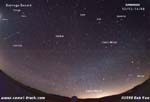 Click for HI-RES image |
NOTE: This is the SAME fireball, as recorded with the 8mm camera (see 16mm section) 40+ deg meteor-trail, in Corvus (pointing toward M42). Note that the meteor is headed towards the eastern horizon, while Orion (& Gemini, the radiant) is setting in the west. Note that the crescent moon (& nearby Mars) are rising in the east. Note the red nebulosity in Monoceros (e.g., Rosette Nebula & *faint* nebula around the Conus Nebula). |
 Click for HI-RES image |
UNDER CONSTRUCTION: come back until Dec 25 for additional images |